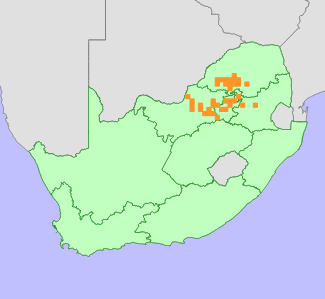|
Scientific Name | Clematis villosa DC. subsp. stanleyi (Hook.) Kuntze |
Higher Classification | Dicotyledons |
Family | RANUNCULACEAE |
Synonyms | Clematopsis scabiosifolia (DC.) Hutch. subsp. stanleyi (Hook.) Brummitt, Clematopsis stanleyi (Hook.) Hutch., Clematopsis villosa (DC.) Hutch. subsp. stanleyi (Hook.) J.Raynal & Brummitt |
National Status |
Status and Criteria | Least Concern |
Assessment Date | 2017/08/21 |
Assessor(s) | L. von Staden |
Justification | This taxon is widespread, common and not in danger of extinction. |
Distribution |
Endemism | Not endemic to South Africa |
Provincial distribution | Gauteng, Limpopo, Mpumalanga, North West |
Range | It is widespread across northern South Africa, from the Witwatersrand to the Waterberg and Middelburg, Mpumalanga. It extends northwards to Angola and Zambia. |
Habitat and Ecology |
Major system | Terrestrial |
Major habitats | Springbokvlakte Thornveld, Egoli Granite Grassland, Rand Highveld Grassland, Eastern Highveld Grassland, Waterberg-Magaliesberg Summit Sourveld, Soweto Highveld Grassland, Dwaalboom Thornveld, Gauteng Shale Mountain Bushveld, Andesite Mountain Bushveld, Central Sandy Bushveld, Carletonville Dolomite Grassland, Loskop Thornveld, Gold Reef Mountain Bushveld, Western Sandy Bushveld, Waterberg Mountain Bushveld, Madikwe Dolomite Bushveld, Zeerust Thornveld, Dwarsberg-Swartruggens Mountain Bushveld, Pilanesberg Mountain Bushveld, Marikana Thornveld, Norite Koppies Bushveld, Moot Plains Bushveld, Loskop Mountain Bushveld |
Description | It occurs in rocky outcrops in grassland and bushveld. |
Threats |
| There are no severe threats to this taxon. |
Population |
This taxon is widespread and abundant across Gauteng and adjacent areas in Limpopo, North West and Mpumalanga. It persists in highly disturbed places, and increases in abundance in areas where thickets are spreading due to fire exclusion and poor land management. In spite of large parts of its distribution range now converted to urban areas, the population is not suspected to be declining.
|
Population trend | Stable |
Assessment History |
Taxon assessed |
Status and Criteria |
Citation/Red List version | | Clematis villosa DC. subsp. stanleyi (Hook.) Kuntze | Least Concern | Raimondo et al. (2009) | |
Bibliography |
Brummitt, R.K. 2000. Inclusion of Clematopsis Hutch, in Clematis L. (Ranunculaceae). Kew Bulletin 55(1):97-108.
Harvey, W.H. 1859. Ranunculaceae. In: W.H. Harvey and O.W. Sonder (eds). Flora Capensis I (Ranunculaceae-Connaraceae):1-7. Hodges, Smith and Co., Dublin.
Hutchinson, J. 1920. Clematopsis, a primitive genus of Clematideae. Bulletin of Miscellaneous Information (Royal Botanic Gardens, Kew) 1920(1):12-22.
Phillips, E.P. 1923. Clematopsis stanleyi. Flowering plants of South Africa 3:t. 81.
Raimondo, D., von Staden, L., Foden, W., Victor, J.E., Helme, N.A., Turner, R.C., Kamundi, D.A. and Manyama, P.A. 2009. Red List of South African Plants. Strelitzia 25. South African National Biodiversity Institute, Pretoria.
Retief, E. and Herman, P.P.J. 1997. Plants of the northern provinces of South Africa: keys and diagnostic characters. Strelitzia 6. National Botanical Institute, Pretoria.
|
Citation |
| von Staden, L. 2017. Clematis villosa DC. subsp. stanleyi (Hook.) Kuntze. National Assessment: Red List of South African Plants version . Accessed on 2025/05/31 |
 Comment on this assessment
Comment on this assessment


